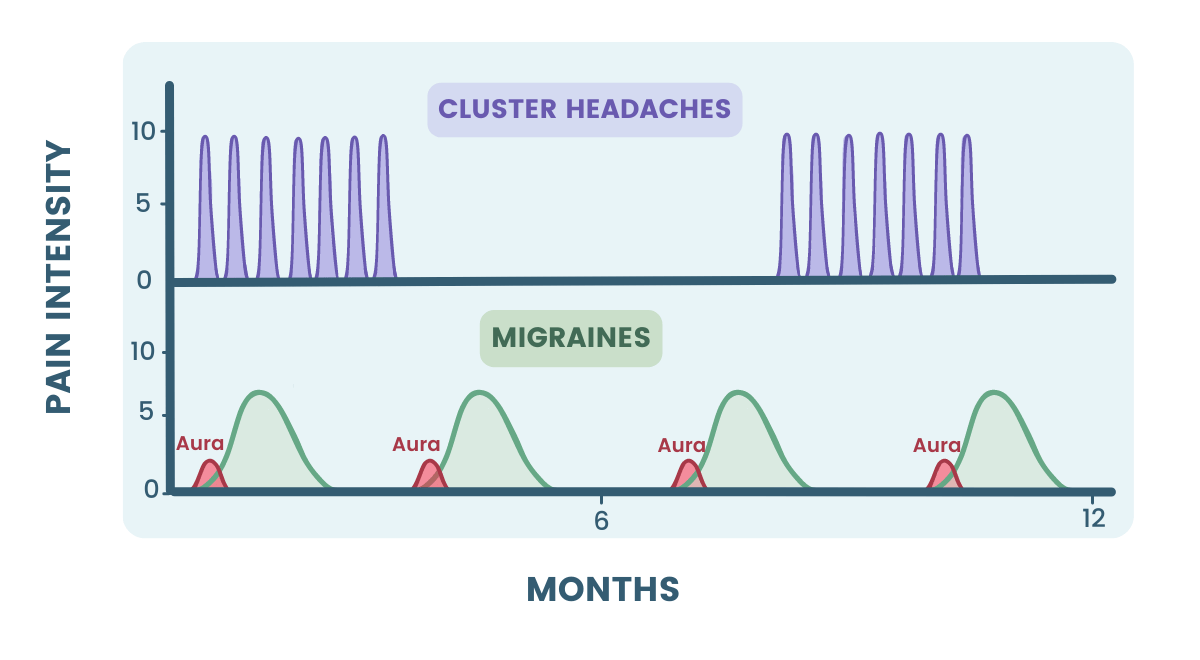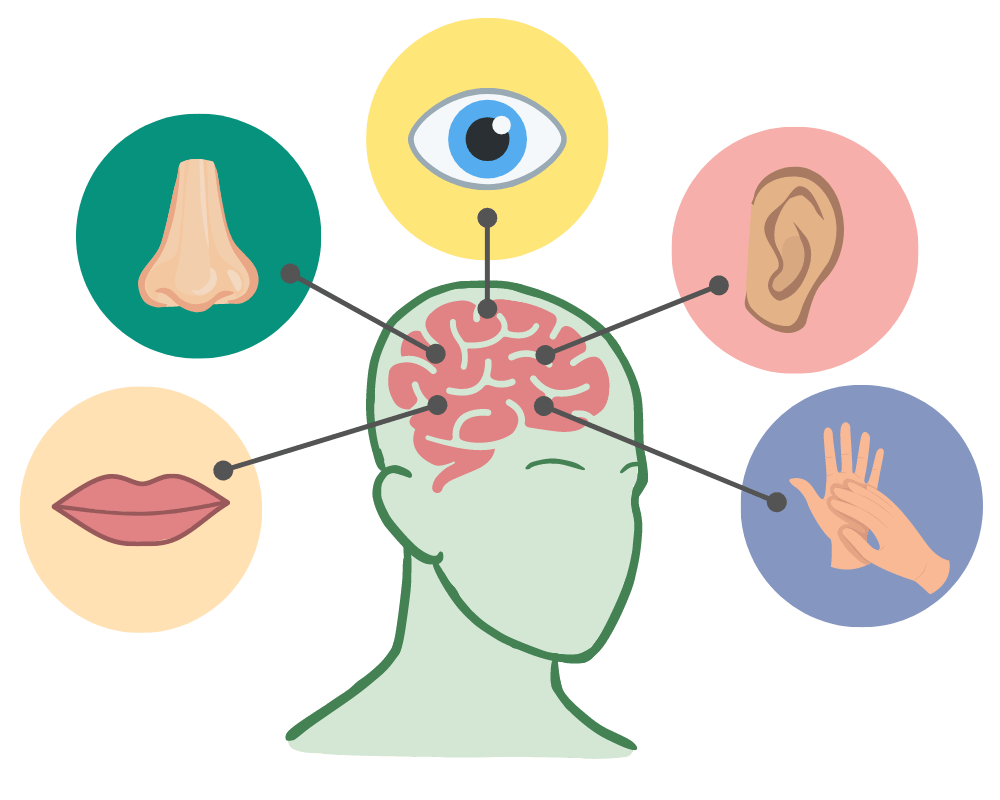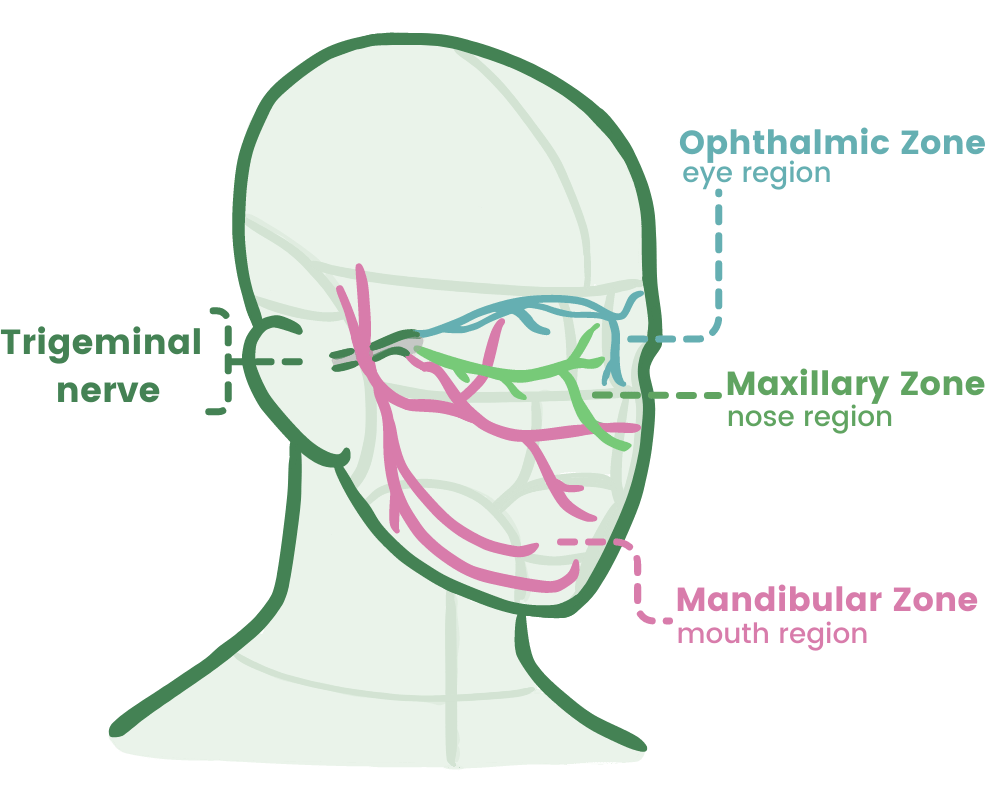
Cluster headaches and migraines are some of the most painful and disruptive headaches you can experience. Despite their differences, the lines between the two can seem pretty blurred, so if you’re experiencing symptoms of either one, it’s important to know the difference.
Here, we’ll break down cluster headaches and migraines so that you can tell them apart yourself and find relief more easily.
A Brief Comparison of Cluster Headaches vs Migraines
| Cluster Headaches | Migraines | |
|---|---|---|
| Location of Pain |
|
|
| Pain Description |
|
|
| Duration and Timeline |
|
|
| Additional Symptoms |
|
|
| Behavior During Attack |
|
|
If you're experiencing these symptoms severely or for the first time, you should seek out medical attention. Many of these symptoms share similarities with other serious conditions like stroke or seizure.
Where Do You Feel Cluster and Migraine Headaches?
Clinical data show that cluster headaches and migraines arise from similar structures in your brain but activate pain using different pathways. So, while their respective types of pain and extra symptoms tend to be unique, there's overlap between where you feel pain:
- Around the eyes
- Deep within the head
- Mostly on one side
Where in Your Head Do You Feel Cluster Headache Pain?
These headaches feel like they’re coming from deep within your brain, but more specifically, as if the pain is coming from the inside out. With some rare exceptions, they usually occur in the same place and don't move from behind your eye.

Where in Your Head Do You Feel Migraine Pain?
Besides feeling pain behind one eye, you can also feel migraines in your temples (the sides of your head), between your eyes, and forehead. Although a migraine typically occurs on one side of your head, it can sometimes occur on both and tends to be more spread out than clusters.

What Do Cluster Headaches and Migraines Feel Like?
There’s a reason these two headache types are easily confused. Types of head pain that they tend to have in common are:
- Throbbing
- Stabbing
- Concentrated
What Do Cluster Headaches Feel Like?
Cluster headaches tend to feel a bit sharper than migraines – the pain is often described as:
- Burning
- Piercing
- Shooting
Patients have reported this as the worst pain of their lives, and lots have called it a 10 on the pain scale.

What Do Migraines Feel Like?
Although throbbing happens with cluster headaches too, those kinds of feelings are more characteristic of migraines. Other types of migraine pain include:
- Pounding
- Pulsing
You can sometimes also feel numbness or tingling on a single side of your face or body. Certain migraines can be as intense as cluster headaches, but they tend to have more flexibility on the pain scale and are more often moderate to severe.

How Long Do Cluster vs. Migraine Headaches Last?
Cluster headaches and migraines look super different in terms of their timelines. Whereas migraines can last anywhere from hours to days, clusters only last minutes to hours and follow a distinct long-term pattern.

How Long Do Cluster Headaches Last?
Cluster headaches last anywhere from fifteen minutes to three hours. They appear in what we call a 'cluster' of time that lasts anywhere from 6 to 12 weeks. They can happen every other day or up to 8 times a day. Cluster periods are then followed by pain-free ‘remission periods’ that last at least three months.
They also tend to show up at night or around the same time every day, which suggests that they have something to do with your circadian rhythm (your internal clock that controls your sleep cycle).

How Long Do Migraines Last?
A migraine can last from four hours to three days. By the time it comes and goes, you may have gone through four stages that all have their own features.
- The prodrome, or pre-pain, stage is usually a day or two before the attack, and it often goes unnoticed. The most notable symptoms are constipation, unexpected mood swings, and neck stiffness.
- The next stage is called an aura, which is another name for all those symptoms besides pain, like light sensitivity and nausea.
- The attack stage is where you’ll feel the most actual pain, and it can last anywhere from a few hours to several days. The effects of an aura are likely still around during this time, and you’ll want to minimize any sensory inputs.
- The post-drome stage occurs in the hours after the pain has subdued and can last about a day. You’ll probably feel worn-out, disoriented, or mentally and physically drained.
What Are Some Additional Symptoms of Cluster Headaches and Migraines?
Aside from pain, migraines and cluster headaches each have additional symptoms that are very telling when it comes to differentiating the two. They both cause issues with your sensory system, which is in charge of vision, smell, taste, touch, and other things of the sort. There are important behavioral differences as well -- whereas cluster headaches make you restless, migraines make you more lethargic.
Cluster Headaches
To be sure it’s a cluster headache, your eyes, nose, and/or mouth will have to show additional symptoms that are on the same side of your head as the headache.
That’ll look like droopy, watery, or bloodshot eyes or a runny or stuffy nose. The additional symptom could also be miosis, which is when both pupils get really small and won’t go back to normal. (If your pupils are different sizes, this is a separate medical issue that deserves medical attention!) On occasion, cluster headaches have also been known to cause sharp tooth and jaw pain.
You might also feel restless. This can look like pacing, rocking back and forth, or even agitation.

Migraines
For migraines, these sensory-related symptoms belong to what we call an aura. Think of it as a current or wave passing through your brain. As it moves, it affects various regions that control your vision, touch, hearing, and motor control.
Some of these effects look very similar to clusters, but there are still some differences. A key difference is nausea or vomiting. You'll also find that if you experience something like congestion or watery eyes during a migraine, it’ll likely be on both sides instead of just one.

- You'll be oversensitive to light and may experience temporary vision loss.
- You might also see a halo of light, as well as dark, fuzzy shapes or lines.
- You can feel numbness or pins and needles in your arms, legs, and sometimes face on one side.
- You’ll likely be more sensitive to noise than normal.
- On occasion, patients can also hear nonexistent noises during an aura.
- You may have trouble speaking or controlling movement.
Due to this sensory overload, behavioral observations of migraine patients show that they usually want to minimize movement and be in quiet, dark rooms.
Symptoms like vision loss and numbness on one side can also resemble a stroke. Seizure symptoms may overlap as well, especially loss of motor control. If you're experiencing these for the first time, or if they differ from previous headaches, seek medical attention.
Why Do We Get Cluster Headaches and Migraines?
Why Do We Get Cluster Headaches?
The main cause of cluster headaches has been traced back to the trigeminal nerve, which extends to the eyes, nose, and mouth. If you’re predisposed to cluster headaches, anything that causes vasodilation (blood vessel expansion) can press on this nerve and cause noticeable effects on these different regions.

Apart from this nerve, there’s little known about the biological sources of cluster headaches, but we do know about some risk factors. During a cluster, these headaches can be triggered or worsened by smoking or alcohol consumption. A cluster of headaches, however, can be triggered by changes in circadian rhythm having to do with seasons or the time of year. For reasons that are not well understood, men are much more likely to experience cluster headaches than women.
Why Do We Get Migraines?
There are a few running theories on why we get migraines – the most popular also have to do with vasodilation, or the widening of blood vessels. The chemical serotonin plays a big part in controlling both blood vessel size and communication of pain, so lots of studies suggest it has a role in migraines. Additional studies suggest that the trigeminal nerve is involved as well, but it’s not as directly linked as in cluster headaches.
Because migraines are 3 times more prominent in women, a few studies suggest they are linked to hormonal changes, although these processes are not well understood.



There’s evidence that genetics play a massive role in migraines. Environmental factors like stress, anxiety, lack of sleep, or depression can all interact with your genes and more easily trigger migraines than in those without certain genetics.
Certain foods can also trigger migraines. Guava's article on how your diet can cause headaches explores this evidence in depth.
How Do I Know This is Just a Cluster Headache or Migraine?
As you saw above, there’s a lot of overlap between symptoms of cluster headaches and migraines, but they can also be indicative of other serious conditions like seizures, strokes, or brain tumors. Here are some overlapping symptoms:
- Intense headache
- Nausea and vomiting
- Visual disturbances
- Sensory changes
- Language problems
- Sudden, severe headache
- Neurological symptoms:
- Weakness
- Confusion
- Difficulty speaking
- Loss of balance
- Headache
- Changes in headache pattern
Knowing the differences between cluster headaches and migraines gives you the power to take control of your pain. Headaches like these can feel incredibly overwhelming, so it’s crucial to know what you’re dealing with. By understanding each type’s unique symptoms and patterns, you can make smarter choices for treatment and relief. Remember, you don't have to suffer in confusion – understanding your headaches puts you in the driver's seat of your well-being.






